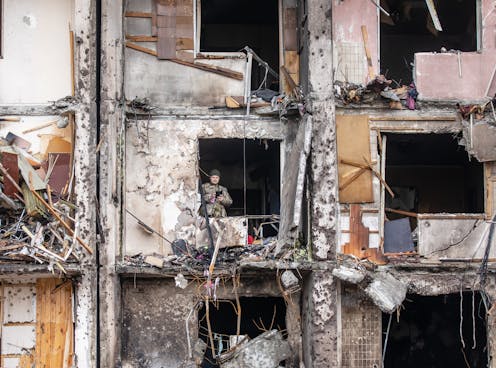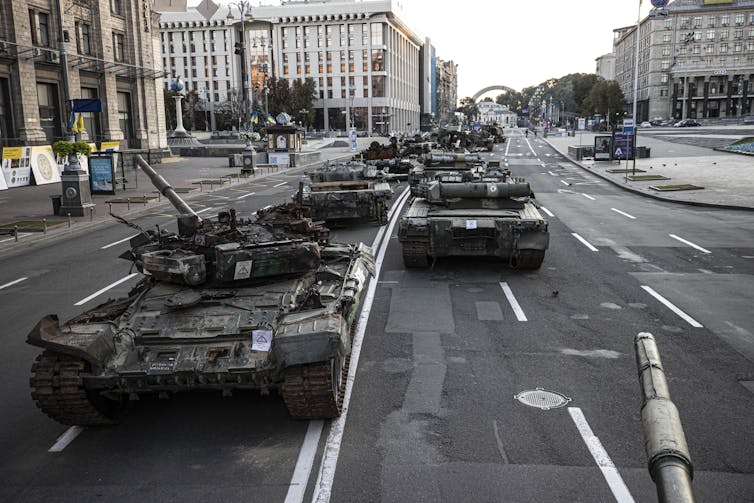
As Ukrainian forces fight a late-summer counterattack to wrest the southern province of Kherson from Russian control, Russian President Vladimir Putin is learning a lesson that many political leaders have learned before: War is often much longer and costlier than anticipated.
In the six months since Russia launched its assault on Ukraine on Feb. 24, 2022, Putin and his military leaders have faced unexpected resistance from Ukrainian forces.
That’s been the case in the southern province of Kherson, where Ukrainian forces launched a counterattack on Aug. 28, 2022. Oleksiy Arestovych, a Ukrainian senior presidential adviser, described the offensive as a “slow operation to grind the enemy.”
Indeed, there appears no end in sight.
As a career U.S. special forces officer with combat and operational deployments in Afghanistan, Iraq, Bosnia, Africa and South America, I conducted field research on the 2008 and 2014 wars in Georgia and Ukraine.
In my view, Russia’s initial strategy that projected a rapid advance into Ukraine’s capital city Kyiv – and a quick capitulation of Ukrainian forces – has not happened because of poor planning, even worse execution and stiff Ukrainian resistance.
In fact, many thought Kyiv would fall within months of the initial invasion. But Russian military leaders were forced in March 2022 to pull all of their forces from the Kyiv region.
The Ukrainian counterattacks near Kyiv also enabled them to regain significant territory around Kharkiv, a region in the northeast section of Ukraine and the third most populous in the country.
A shift in battle tactics
As wars drag on – as they often do – they go through different phases. The war in Ukraine has been no different.
The opening weeks of the Russian assault on Ukraine was largely a war of maneuver, in which a military uses movement to keep an enemy off balance by fighting when and where it held an advantage.
It became clear that in a war of maneuver, the Ukrainians held a slight edge despite the overwhelming size of the Russian military as compared with Ukraine’s.
Russia’s 2022 military budget, for instance, is US$45.8 billion, about 10 times the size of Ukraine’s $4.7 billion.
More staggering is Russia’s advantage in active personnel – 900,000 to 196,000 – and in armored vehicles – 15,857 to 3,309.
But maneuver warfare requires a well-trained and well-led fighting force to execute synchronized movements.
Over the past six years, with the help of Western allies, Ukraine built a well-trained and well-led fighting force capable of executing synchronized combat manuevers.
As a result, Ukraine defended where it had to – as in Kyiv – and gave up terrain where it had little choice but to retreat, such as Donetsk and the Luhansk regions in the industrialized southeastern part of Ukraine.
After its poor performance in the opening days, Russia’s military leaders learned that they lacked a fighting force capable of winning a war of maneuver and shifted to a war of attrition.
In such wars, troop and equipment movement is limited and instead involves assembling soldiers and military equipment in a relatively fixed location to destroy enemy forces and weapons.
In these types of wars, the goal is to weaken the enemy over time. The fighting is characterized by large artillery barrages and slow advances that are reminiscent of World War I, in which both sides were dug into trenches and unable to advance their forces.
This style of warfare favors Russia’s only strength: overwhelming fighting capacity, supported by massive numbers of troops.
Ukrainian resistance and urban combat
Ukrainian volunteers played a critical role in the defense of the nation in 2014 when they flocked to the Donbas region to fight the Russian assault.
In the opening stage of this latest Russian assault, the volunteers played a similiar role in the defense of Kyiv.
Tens of thousands of civilians grabbed rifles and any other weapons they could find – including captured Russian weapons – to help win the battle for their nation’s capital.

These volunteers have also played a role in providing intelligence and conducting attacks and sabotage in Russian-occupied territory.
The battle of Mariupol, fought for nearly three months between Feb. 24 and May 20, 2022, illustrates how a few thousand Ukrainian soldiers were able to hold out for more than a month against a force 10 times its size.
Despite the challenges that urban combat entails, Russia cannot simply bypass metropolitan areas. Local governance and political power reside in cities. If the war is about occupying and controlling territory, then Russia is forced to fight in urban areas, arguably the most difficult environment in which to fight.
A well-trained and motivated defender is afforded countless places to hide.
What comes next?
At the current pace of Russian advances, it would take decades for the Russian military to reach Kyiv.
Given its economy and arsenal, which is eroding daily, it seems unlikely Russia can wage this level of conflict for another decade.
What seems most likely, in my view, is that this war of attrition will continue until one side is either defeated or exhausted, and that is likely years away.

Neither side appears to have the capacity to defeat the other. As a result, a military victory appears unlikely, and the war may prove too costly for Russia, forcing it to leave as it did Afghanistan in 1989 after 10 years of war there.
Nor, in my view, will the Ukrainian government capitulate or enter into any agreement that gives Russia control of any land that Russia now occupies such as in the Donbas region.
Time, instead, could favor the Ukrainians. The arrival of new weapon systems, such as the HIMARS artillery rocket system, is eroding Russia’s slight edge in the current war of attrition and contributing to Ukraine’s ability to launch a large-scale counterattack.
But only time will tell.
Ukrainian resistance depends on continued Western aid. Ultimately, a military needs weapons to destroy an enemy, and the necessity of Western support for Ukrainian resistance cannot be overstated.
Liam Collins does not work for, consult, own shares in or receive funding from any company or organization that would benefit from this article, and has disclosed no relevant affiliations beyond their academic appointment.
This article was originally published on The Conversation. Read the original article.







